Journal of Nutrition & Food Sciences
Open Access
ISSN: 2155-9600
ISSN: 2155-9600
Review Article - (2025)Volume 15, Issue 6
COVID-19 has affected various aspects of human life, including food habits and preferences. In addition to affecting food habits and preferences, the pandemic has had far-reaching effects on human life and behaviour. The objective of this research paper is to study and investigate the changes in dietary patterns, nutrition intake and awareness in following healthy behaviour and explore their long-term potential effects on deteriorating human health. We used mixed method approach by using quantitative and qualitative data which was collected from different population and different region. The survey conducted assessed changes in food preference, food intake which was required for a healthy lifestyle. This helped us gain valuable insights into the psychological, socioeconomic factors influencing this behaviour. This research paper investigate the long term impact of the pandemic on individual health outcomes, prevalence of health related disease, how an individual will cope with it and also in determining underlying disease caused due to psychological distress.
The COVID-19 pandemic, which was an unprecedent global crisis which affected various aspects of human life and was responsible for killing millions of people worldwide as it was a virus and its basic characteristic was mutation which was essential for its survival in the host and for this reason scientists could not find the cure for this deadly disease and hence vaccination was ineffective [1].
It caused a sudden change in immediate health and economic impact, which played a factor in influencing food preferences. The measures implemented to prevent the spread of the virus such as travel restriction, social distancing and lockdown, which significantly changed people’s daily routine and access to food. The fear and uncertainty which aroused due to this pandemic paid a significant role in how people adjust to this new lifestyle and cope with stress and hence consume the food.
This research paper aims to provide a comprehensive analysis of the effects of the COVID-19 pandemic on food habits and preferences. It examines the changes observed in food consumption patterns, dietary habits, and food preferences during and after the pandemic, considering both short-term and potential long-term consequences. The pandemic has brought about various disruption in food consumption patterns. The food supply chain was strongly impacted in the early stages of the pandemic due to panic buying and stockpiling of food items.
Moreover, the pandemic has had an impact on dietary habits and nutritional choices. The stress and uncertainty associated with the crisis have led to emotional eating and increased snacking, potentially contributing to less balanced diets. The limitations on eating out and the fear of contagion have also affected individuals' choices regarding restaurant food, with a shift towards home-cooked meals [2].
Changes in food consumption habits
The COVID-19 pandemic has had a profound impact on our day to day routines, including food consumption habits. At the onset of the pandemic, there was a surge in panic buying and stockpiling of essential food items. Consumers rushed to grocery stores, resulting in shortages and imbalances in the food supply chain. Staple items such as rice, pasta, canned goods, and cleaning supplies experienced high demand, leading to temporary scarcity in some regions. The pandemic has influenced people's choices regarding the types of food they consume. With increased time spent at home and limited access to dining out options, individuals have turned to more shelfstable and long-lasting foods. Non-perishable items, frozen foods, and canned goods have become more popular due to their extended shelf life and ease of storage. Additionally, there has been a rise in the consumption of comfort foods and indulgent snacks as people seek emotional comfort during these challenging times. The closure of restaurants and restrictions on dining out have led to a significant increase in home cooking and baking. With more time spent at home, individuals have taken up cooking as a way to pass the time, experiment with new recipes, and engage in creative culinary pursuits. he pandemic has heightened awareness of health and wellbeing, leading to an increased emphasis on consuming foods perceived as healthy and immune-boosting [3].
Dietary habits and nutritional changes
The COVID-19 pandemic has had a significant impact on dietary habits and nutritional choices. The disruption caused by the pandemic has influenced individuals' ability to maintain balanced diets. Stress, anxiety, and changes in daily routines have led to irregular eating patterns and disrupted meal schedules. Many people have reported emotional eating and increased snacking as a way to cope with the uncertainty and stress associated with the pandemic. The confinement and emotional strain of the pandemic have contributed to an increase in snacking and emotional eating. People often turn to food for comfort during times of stress, which can lead to excessive consumption of energy-dense, nutrient-poor foods. The proximity to the kitchen and easy access to snacks at home have further facilitated this behaviour. Emotional eating and snacking can contribute to weight gain and an imbalanced nutrient intake [4].
Factors affecting food preferences
Psychological factors: The pandemic has brought about increased stress, anxiety, and emotional upheaval for many individuals. Psychological factors, such as comfort-seeking, boredom, and the need for emotional support, can significantly impact food preferences. Comfort foods, which are often associated with positive emotions and nostalgia, have gained popularity as people seek solace and familiarity during challenging times. Additionally, boredom and monotony may lead to a desire for novelty, prompting individuals to try new recipes or explore different cuisines.
Health concerns and immune-boosting foods: The heightened focus on health and well-being during the pandemic has influenced food preferences. Individuals are more conscious of their immune system's role in fighting infections, leading to an increased interest in foods believed to boost immunity. There is a growing preference for fruits, vegetables, whole grains, lean proteins, and foods rich in vitamins, minerals, and antioxidants. People are actively seeking out foods that support their overall health and enhance their immune function [5].
Sustainability and ethical considerations: The pandemic has highlighted the interconnectedness between human health, animal welfare, and the environment. This awareness has influenced food preferences, with individuals showing a greater interest in sustainable and ethical food options. There is a growing demand for locally sourced, organic, and environmentally friendly foods. Consumers are considering factors such as carbon footprint, animal welfare standards, and support for local farmers and producers when making food choices.
Access to food and availability: The availability and accessibility of food have a significant impact on food preferences during the pandemic. Disruptions in the food supply chain, temporary shortages, and limited access to certain food items have influenced what people choose to consume. Individuals may opt for alternative ingredients or substitute their preferred choices based on what is readily available. Economic factors also play a role, as affordability and budget constraints may shape food preferences.
Social and cultural influences: Social and cultural influences continue to shape food preferences during the pandemic. Social media platforms, online communities, and virtual interactions have become avenues for sharing recipes, food trends, and recommendations. These platforms influence individuals' choices by exposing them to new ideas and food experiences. Cultural traditions and family practices also influence food preferences, as individuals may seek comfort in familiar foods or engage in cooking practices that reflect their cultural heritage [6].
Long term effects and implications
The COVID-19 pandemic has the potential to bring about longterm effects and implications for food habits and preferences. Understanding these effects is essential for anticipating shifts in behaviour and addressing the broader implications they may have on public health, food systems, and sustainability. The following are some potential long-term effects and their implications:
Changes in dietary preferences: The pandemic has disrupted established food habits and preferences, leading to potential long-term changes in dietary preferences. Increased home cooking, reliance on shelf-stable and long-lasting foods, and a greater emphasis on health and nutrition may persist beyond the pandemic. People may continue to prioritize cooking meals from scratch, incorporating more fruits and vegetables into their diets, and seeking out foods that support their immune systems.
Implication: This presents an opportunity to promote healthier eating habits and support sustainable food choices. Public health campaigns, educational initiatives, and food industry efforts can focus on promoting nutritious and sustainable food options that align with the changed dietary preferences.
Heightened awareness of food safety and hygiene: The pandemic has heightened public awareness of food safety and hygiene practices. People have become more conscious of the importance of proper food handling, cleanliness, and sanitization. This increased awareness is likely to influence food preferences and consumption behaviours in the long term, with individuals being more cautious about the sources and preparation of their food.
Implication: The food industry will need to adapt and prioritize food safety and hygiene practices to meet the expectations of consumers. Enhanced regulations, certifications, and transparency in the food supply chain can help build trust and ensure the long-term safety and quality of the food consumed.
Shifts in sustainable food choices: The pandemic has brought sustainability and ethical considerations to the forefront of discussions around food choices. Individuals have shown an increased interest in local and seasonal foods, support for smallscale farmers and producers, and a desire to reduce their environmental footprint. This shift towards sustainable food choices may continue as people become more conscious of the environmental impact of their dietary decisions.
Implication: The food industry can respond to this shift by prioritizing sustainable practices, such as reducing food waste, adopting eco-friendly packaging, and promoting regenerative agriculture. Encouraging local food systems, communitysupported agriculture, and providing clear information about the origin and sustainability of food products can further support this trend [7].
Data collection
• We prepared a set of questions to collect the data. The questions were:
• Did you caught COVID?
• Are you suffering from any eating disorder?
• Has COVID affected your food habits?
• Do you think there is an increase in your diet intake during lockdown?
• How would you describe yourself?
• Do you observe any change in food preferences after COVID?
• What type of body image do you have about yourself (According to BMI)
• How often do you go out for eating?
• Do you like to try new restaurant/cafe?
• Do you like to try new dishes?
• How much money do you spend on your food expenses monthly?
• Do you think it is important to have a healthy diet?
• Do you think healthy body breeds a healthy mind?
• Are you planning to start a proper diet schedule after covid?
• Do you think it is important to do regular exercise or gym?
We got a variety of responses, which helped us in successfully completing our survey and helped us in publishing this research paper (Figures 1-6).
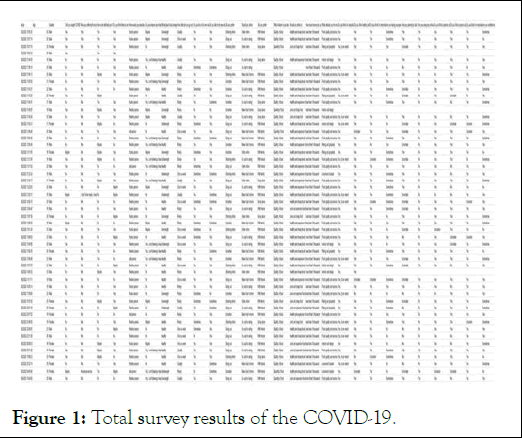
Figure 1: Total survey results of the COVID-19.
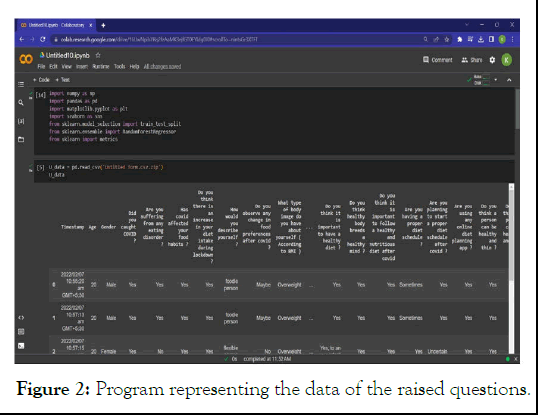
Figure 2: Program representing the data of the raised questions.
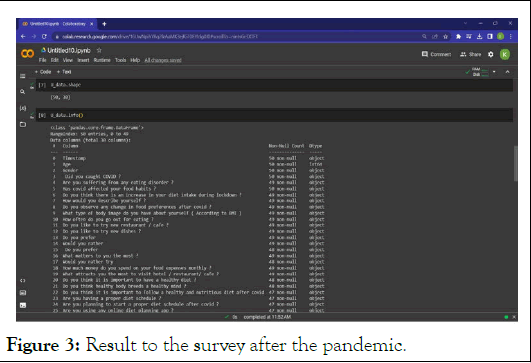
Figure 3: Result to the survey after the pandemic.
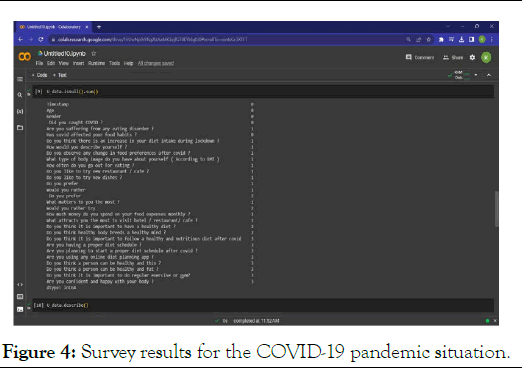
Figure 4: Survey results for the COVID-19 pandemic situation.
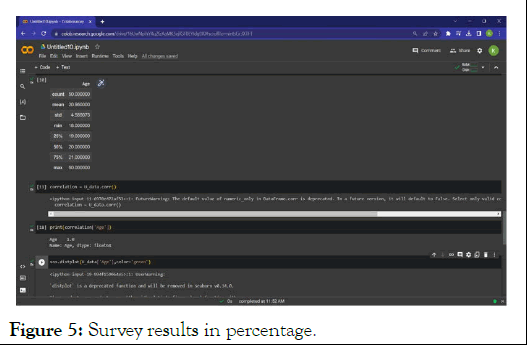
Figure 5: Survey results in percentage.
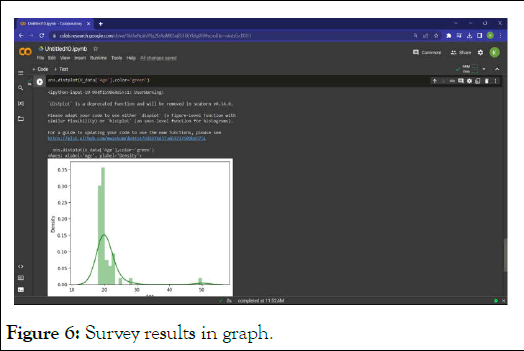
Figure 6: Survey results in graph.
Strategies for promoting healthy and sustainable eating
We must promote healthy and sustainable eating for the longterm sustainability of our food systems and for our individual well-being. Keeping our food systems sustainable and healthy is crucial for individual well-being and our long-term well-being. Our food systems must be sustained long-term by promoting sustainable and healthy eating. Healthy eating is essential to individual well-being as well as long-term food sustainability. In order to ensure the long-term sustainability of our food systems, it is crucial that we promote healthy and sustainable eating. Healthy and sustainable eating is crucial to individuals' wellbeing and the sustainability of the food system. Healthy eating and sustainable food systems are essential to individual wellbeing and long-term food system sustainability. Our food systems and individual well-being rely on the promotion of sustainable and healthy diets.
• Public health campaigns: Develop and implement public health campaigns that raise awareness about the importance of healthy eating and sustainable food choices. These campaigns can provide information on the benefits of consuming a balanced diet, highlight the environmental impact of food choices, and promote local and seasonal produce.
• Nutrition education: Provide comprehensive nutrition education in schools, community centres, and healthcare settings. Teach individuals about the importance of nutrientrich foods, portion control, and mindful eating. Empower individuals to make informed choices by providing them with practical knowledge on reading food labels, meal planning, and cooking healthy meals.
• Sustainable food systems: Support and invest in sustainable agriculture practices that prioritize soil health, water conservation, and biodiversity. Encourage the use of regenerative farming techniques that restore and enhance the natural resources used in food production. Promote local and regional food systems to reduce the carbon footprint associated with long-distance transportation.
• Food waste reduction: Implement initiatives to reduce food waste throughout the supply chain and at the consumer level. Encourage proper food storage, meal planning, and creative ways to utilize leftovers. Support food recovery programs that redirect surplus food to those in need.
• Behavioural nudges: Utilize behavioural science techniques to nudge individuals towards healthier and sustainable food choices. This can include strategies such as placing healthier options prominently in food environments, utilizing appealing signage and visuals, and making sustainable choices the default option in cafeterias and food delivery platforms.
• Policy and regulation: Advocate for policies that support healthy and sustainable eating. This can include implementing taxes on unhealthy foods, restricting the marketing of unhealthy products to children, and providing incentives for sustainable farming practices.
In conclusion, the COVID-19 pandemic has brought about significant changes in food habits and preferences, with potential long-term effects and implications. The shifts observed in dietary choices, such as increased home cooking, emphasis on health and immune-boosting foods, and a greater focus on sustainability, provide opportunities for promoting healthier and more sustainable eating habits. Addressing these changes requires a multi-faceted approach. Public health campaigns, nutrition education, and improved food labeling and transparency can empower individuals to make informed choices aligned with their health and sustainability goals. Ensuring access to healthy food in underserved communities and collaborating with the food industry to offer healthier options are crucial steps toward creating a supportive food environment.
Promoting sustainable food systems, reducing food waste, and supporting regenerative agriculture practices are essential for building a resilient and environmentally friendly food system. Embracing digital technologies while addressing digital inequalities can enhance access to diverse food options and knowledge-sharing platforms.
It is evident that a comprehensive strategy is needed to promote healthy and sustainable eating in the post-pandemic era. By implementing strategies that encompass education, accessibility, collaboration, and policy changes, we can work towards a future where individuals are empowered to make choices that benefit their well-being, the environment, and the sustainability of our food systems.[Crossref][Google Scholar] [PubMed]
[Crossref] [Google Scholar] [PubMed]
[Google Scholar] [Crossref][PubMed]
[Crossref] [Google Scholar] [PubMed]
Citation: Makkar K, Bisena A (2025) Examining the Impact of COVID-19 on Eating Preferences. J Nutr Food Sci. 15:065.
Received: 22-Sep-2023, Manuscript No. JNFS-23-26200; Editor assigned: 27-Sep-2023, Pre QC No. JNFS-23-26200 (PQ); Reviewed: 11-Oct-2023, QC No. JNFS-23-26200; Revised: 14-Jun-2025, Manuscript No. JNFS-23-26200 (R); Published: 21-Jun-2025 , DOI: 10.35248/2155-9600.25.15.065
Copyright: © 2025 Makkar K, et al. This is an open-access article distributed under the terms of the Creative Commons Attribution License, which permits unrestricted use, distribution, and reproduction in any medium, provided the original author and source are credited.